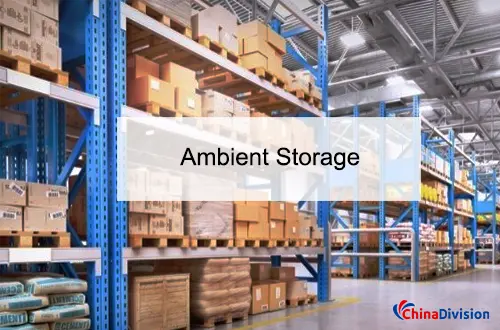What is Ambient Storage in International Warehousing?
Choosing the right storage conditions for your products is crucial. Ambient storage, as a cost-effective warehousing solution that ensures quality while controlling costs, is becoming a popular choice in international logistics. While terms like refrigerated storage, constant temperature storage, and ambient temperature storage are often used, many companies struggle to distinguish between them—especially when deciding which option best meets their inventory needs.
Table of Contents
As a leading third-party warehousing service provider, ChinaDivision specializes in optimizing warehousing solutions for a wide range of industries. In this blog, we'll demystify ambient warehousing, explain how it compares to other temperature-controlled warehousing options, and address common pain points to help you make an informed decision.
What is ambient storage?

Ambient warehousing involves storing goods in a room-temperature warehouse environment, typically between 15°C and 25°C (59°F and 77°F), without the need for additional temperature control equipment, and maintaining a controlled relative humidity between 30% and 70%. Unlike refrigeration (maintaining subzero temperatures) or constant temperature and humidity storage (precisely regulating the temperature and humidity of sensitive items), ambient warehousing is ideal for products that don't require specialized conditions.
Key Characteristics of Ambient Storage
Stable Temperature: Maintains goods within the room temperature range, preventing spoilage due to temperature fluctuations.
Moderate Humidity: While humidity isn't actively controlled, warehouses typically have ventilation and dehumidification systems to prevent corrosion and mold.
Cost-Effective: Eliminates the need for expensive refrigeration equipment, resulting in lower operating costs compared to refrigerated or climate-controlled solutions.
Energy-Efficient: Requires no expensive cooling systems or constant monitoring.
Versatile: Suitable for a wide range of products, including dry goods, electronics, textiles, and non-perishable items. Compared to cold storage and climate-controlled storage, ambient storage offers cost-effectiveness and flexibility, making it the preferred storage solution for many businesses.
What products are suitable for ambient storage?
Dry foods: rice, noodles, cereals, biscuits, and instant foods
Canned foods: fruit, vegetables, and meat
Electronics: headphones, accessories, and home appliances
Household goods: clothing, stationery, toys, and books
Medical products: over-the-counter medications and health supplements (need to confirm room temperature compatibility)
Ambient storage vs. refrigerated and climate-controlled storage
Businesses often confuse these terms, leading to unnecessary expenses and product damage. Here's a brief comparison:
Ambient storage, typically operating at room temperature (15°C–25°C), is best suited for electronics, clothing, and household goods. It's also cost-effective because it doesn't require expensive refrigeration equipment or specialized climate control systems.
Refrigerated storage, typically operating at 0°C–5°C (or lower), is best suited for fresh produce, pharmaceuticals, and meat, but it carries the highest costs. Refrigerated storage prevents spoilage and bacterial growth by maintaining strict refrigerated conditions.
Climate-controlled storage typically maintains a temperature range of 15°C–25°C and a humidity level of around 30%–50%. It's best suited for art, wine, cosmetics, and chemicals, and has a moderate to high cost.
When should you choose ambient storage?
Your products are non-perishable and stable at room temperature.
You need a cost-effective solution without compromising quality.
Your inventory includes electronics, textiles, or dry-packed goods.
Examples of potential applications:
Cross-border e-commerce: Long-term inventory of non-perishable goods;
Seasonal inventory: Flexible storage needs during promotional seasons;
Transit hubs: Serving as buffer warehouses within global logistics networks to shorten last-mile delivery times.
Ambient Storage FAQs
Is ambient temperature storage safe for all products?
Not all products maintain their condition well at ambient temperatures. Items like chocolate, candles, or certain chemicals may melt or degrade if exposed to temperature fluctuations. Always check the manufacturer's guidelines.
What's the difference between ambient storage and "dry storage"?
While the two terms are sometimes used interchangeably, dry storage typically emphasizes low humidity (less than 50%) to prevent mold, while ambient storage focuses on moderate temperatures and humidity for general use.
Can ambient storage reduce shipping delays?
Of course! By storing inventory in strategically located, temperature-controlled warehouses, we can minimize last-mile delivery times.
Does ambient storage support large-volume storage?
Of course. Chinadivision's warehousing facilities feature high-density racking and automated inventory management, making them ideal for e-commerce peak seasons and large B2B orders.
Why choose Chinadivision's ambient storage services?
As a professional third-party warehousing service provider, Chinadivision provides efficient, reliable, and cost-effective ambient storage solutions to customers worldwide:
Global warehousing network: Our warehouses ensure your goods are stored nearby, shortening shipping times.
Smart inventory management: Our advanced WMS system tracks inventory in real time, keeping you informed of your shipment's movements. Flexible Scalability: Adjust storage space at any time based on business needs to accommodate peak sales seasons or business expansion.
Seamless Logistics Integration: Integrate warehousing and distribution to optimize supply chain efficiency.
Cost Optimization: Save up to 40% in logistics costs compared to building your own warehouse.
Strategic Warehouse Location: Located near major ports and logistics hubs, improving delivery efficiency.
Global E-commerce Platform Integration: Seamlessly connect with Shopify, Amazon, eBay, and more.
Whether you're a B2B trader or a cross-border e-commerce seller, choosing the right warehousing solution is crucial. Ambient storage, with its affordability, flexibility, and wide applicability, is an ideal choice for most businesses.
As an experienced third-party warehousing service provider, Chinadivision not only provides high-quality ambient storage services but also integrates comprehensive logistics solutions, including warehousing, sorting, packaging, and distribution, significantly improving your supply chain efficiency.
If you're looking for a reliable, flexible, and cost-effective warehousing solution, Chinadivision's ambient storage service is the ideal choice. Contact us for a customized solution to make your logistics faster, more stable, and more economical!





